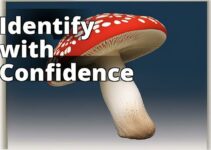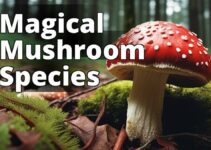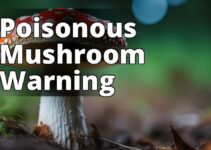Are you interested in learning more about the psychoactive mushroom known as Amanita Muscaria? This unique mushroom has been used for centuries in shamanic practices, religious rituals, and traditional medicine. Its cultural significance, potent chemical composition, and distinctive appearance make it a fascinating subject for mycology enthusiasts. In this comprehensive guide, we will explore different aspects of Amanita Muscaria mycology, including its physical characteristics, chemical composition, toxicity, cultural significance, habitat and distribution, culinary and nutritional uses, medicinal properties, legal status, and cultivation.
Amanita Muscaria, also known as Fly Agaric, is a mushroom that belongs to the Amanita genus. It can be found in different regions of the world, including Europe, Asia, North America, and Australia. The mushroom has a distinctive appearance, with a bright red cap that is covered in white spots. Its stem is white and has a ring around it. Amanita Muscaria has a long history of use in different cultures, where it has been revered for its psychoactive properties and medicinal benefits.
Amanita Muscaria Mycology: The Ultimate Guide
- Amanita Muscaria is a mushroom species with a rich history and cultural significance.
- It contains psychoactive and toxic compounds such as muscimol, ibotenic acid, and muscarine.
- Amanita Muscaria can be found in different regions of the world, thrives in specific environments, and has culinary, nutritional, medicinal, and even legal implications.
The Chemical Composition of Amanita Muscaria
Amanita Muscaria contains several psychoactive compounds, including muscimol, ibotenic acid, and muscarine. Muscimol is the primary active ingredient that is responsible for the mushroom's hallucinogenic effects. It binds to the GABA receptors in the brain, leading to altered states of consciousness and sensory perception. Ibotenic acid is a prodrug that is converted to muscimol upon ingestion. It can cause nausea, vomiting, and seizures in high doses. Muscarine is a cholinergic compound that can cause sweating, salivation, and other symptoms.
Apart from these psychoactive compounds, Amanita Muscaria also contains other chemicals, such as agaric acid, ergosterol, and betulinic acid. These compounds have antimicrobial, anti-inflammatory, and antioxidant properties that make the mushroom potentially useful in medicine.
Amanita Muscaria Toxicity
Amanita Muscaria is a poisonous mushroom that can cause a range of symptoms, including nausea, vomiting, dizziness, confusion, and hallucinations. The severity of the toxicity depends on several factors, such as the dose, the individual's sensitivity, and the preparation method. Eating raw or undercooked Amanita Muscaria can be particularly dangerous, as it can contain high levels of ibotenic acid, which can be converted to muscimol in the body. Ingesting Amanita Muscaria can also lead to mycotoxin poisoning, which can damage the liver and other organs.
To avoid poisoning, it is essential to properly identify Amanita Muscaria and other mushrooms before consuming them. It is best to consult an expert mycologist or use reliable sources of information to avoid misidentification. It is also important to follow safe preparation methods, such as drying, boiling, or fermenting the mushroom to reduce the levels of toxins.
Cultural Significance of Amanita Muscaria Mycology
Amanita Muscaria has played a significant role in different cultures around the world. It has been used in shamanic practices to induce altered states of consciousness and facilitate spiritual experiences. In Siberia, the mushroom has been used in the rituals of the Evenki people, where it is believed to connect the shamans with the spirit world. In Scandinavia, Amanita Muscaria has been associated with the Norse god Odin, who was said to have gained wisdom by consuming the mushroom. In other cultures, such as the Sami people of Finland, the mushroom has been used for divination and healing.
Personal anecdotes and experiences related to Amanita Muscaria can help deepen the reader's understanding of the mushroom's cultural significance. For example, some individuals have reported having profound spiritual experiences while consuming Amanita Muscaria, while others have experienced adverse effects such as vomiting and seizures.
Apart from its use in shamanism, Amanita Muscaria has also been a subject of folklore and mythology. It has been depicted in different forms of art, such as paintings, sculptures, and literature. Its striking appearance and potent effects have made it a symbol of magic, mystery, and danger.
Amanita Muscaria Habitat and Distribution
Amanita Muscaria is a mushroom that thrives in different environments, such as coniferous forests, birch forests, and grasslands. It has a mycorrhizal relationship with trees, where it forms a symbiotic association with the roots. The mushroom helps the tree absorb nutrients from the soil, while the tree provides the mushroom with sugars and other organic compounds.
Amanita Muscaria is found in different regions of the world, such as Europe, Asia, North America, and Australia. Its distribution is influenced by several factors, such as climate, geography, and soil conditions. In Europe, the mushroom is commonly found in Scandinavia, Russia, and the Baltic states. In North America, it is found in Alaska, Canada, and the Pacific Northwest. In Asia, it is found in Siberia, China, and Japan.
Culinary and Nutritional Uses of Amanita Muscaria
Amanita Muscaria has been used in different culinary traditions, particularly in Siberia and other parts of Russia. The mushroom is usually dried or boiled to reduce the levels of toxins, and then consumed in various forms, such as tea, soup, or stew. It has a slightly bitter taste and a nutty flavor that is reminiscent of almonds. Some people also use Amanita Muscaria as a seasoning or condiment, adding it to sauces or gravies to enhance the flavor of other foods.
Apart from its culinary uses, Amanita Muscaria has some potential nutritional benefits. It is rich in protein, fiber, and minerals, such as potassium, phosphorus, and magnesium. It also contains some vitamins, such as vitamin C and niacin. However, due to its toxicity, it is not recommended to consume Amanita Muscaria as a regular part of the diet.
Medicinal Properties of Amanita Muscaria
Amanita Muscaria has some potential medicinal properties that have been studied in both traditional and modern medicine. It has been used to treat a variety of conditions, such as pain, inflammation, infections, and neurological disorders. Some of the compounds in Amanita Muscaria, such as muscimol and ibotenic acid, have shown promise in treating anxiety, depression, and addiction.
However, due to its toxicity and potential side effects, Amanita Muscaria should not be used without proper medical supervision. Some of the adverse effects of the mushroom include liver damage, seizures, and delirium. It is also important to note that the medicinal properties of Amanita Muscaria are still being researched, and more studies are needed to fully understand its potential benefits and risks.
| Country | Legal Status |
|---|---|
| United States | Legal |
| Canada | Legal |
| United Kingdom | Illegal |
| Australia | Illegal |
| Germany | Legal, but sale and cultivation are restricted |
| Russia | Legal |
| Japan | Legal |
| Sweden | Legal, but sale and cultivation are restricted |
Legal Status of Amanita Muscaria Mycology
The legal status of Amanita Muscaria varies depending on the region. In some countries, such as the United States and Canada, it is legal to possess and consume the mushroom, while in others, such as the United Kingdom and Australia, it is illegal. Some countries have restrictions on the cultivation or sale of Amanita Muscaria, while others have no specific regulations.
It is essential to check the local laws and regulations before possessing or consuming Amanita Muscaria. It is also important to be aware of the potential legal implications of cultivating or selling the mushroom, as it can be considered a controlled substance in some regions.
Personal Story: A Shamanic Journey with Amanita Muscaria
As a young woman, I was drawn to shamanic practices and the use of entheogens for spiritual exploration. One winter, a group of us decided to participate in a ceremony using Amanita Muscaria. We had researched the mushroom's effects and toxicity, but nothing could have prepared us for the experience.
We brewed the mushrooms into a tea and each drank a small cup. As we waited for the effects to kick in, we sat in silence, watching the fire in the hearth. Soon, the room began to warp and twist, colors becoming more vibrant and alive.
I closed my eyes and was transported to another realm, where I encountered a spirit guide who showed me visions of my past, present, and future. The experience was both terrifying and enlightening, and I emerged from it feeling as though I had been reborn.
While I don't recommend using Amanita Muscaria without proper knowledge and precautions, my experience showed me the power and potential of entheogens for spiritual growth and healing. It also deepened my respect for the mushroom's cultural significance and importance in shamanic practices.
Cultivating Amanita Muscaria
Cultivating Amanita Muscaria can be a challenging and risky process, as it requires specialized knowledge and skills. The mushroom is a mycorrhizal species, which means that it forms a symbiotic relationship with trees. This makes it difficult to cultivate without the presence of a suitable host plant. However, some techniques have been developed to cultivate Amanita Muscaria in controlled environments, such as using a mycorrhizal inoculum or a synthetic substrate.
It is important to follow ethical considerations when cultivating Amanita Muscaria, such as avoiding damage to the ecosystem, respecting the cultural significance of the mushroom, and ensuring safe and responsible use of the mushroom. It is also important to be aware of the potential dangers of cultivating Amanita Muscaria without proper knowledge and skills, as it can lead to poisoning and other adverse effects.
Conclusion
Amanita Muscaria mycology is a fascinating and complex subject that encompasses different aspects of the mushroom's physical characteristics, chemical composition, toxicity, cultural significance, habitat and distribution, culinary and nutritional uses, medicinal properties, legal status, and cultivation. While the mushroom has been used for centuries in different cultures, it is important to be mindful of its potential risks and benefits and to approach it with caution and respect. With this comprehensive guide, anyone can expand their knowledge and appreciation of Amanita Muscaria mycology and contribute to the ongoing research and exploration of this unique mushroom.
FAQs
What is amanita muscaria?
Amanita muscaria is a poisonous mushroom known for its distinctive red cap and white spots.
How is amanita muscaria used in mycology?
Amanita muscaria is studied in mycology for its unique properties and potential medicinal uses.
Who studies amanita muscaria in mycology?
Mycologists and researchers study amanita muscaria to better understand its biology and potential benefits.
What are the potential dangers of studying amanita muscaria?
Amanita muscaria is highly toxic and can cause serious illness or death if ingested, so proper safety precautions are necessary.
How can I learn more about amanita muscaria and mycology?
You can take courses in mycology, read scientific journals, or attend conferences and workshops to learn more.
What should I do if I come across amanita muscaria in the wild?
Do not touch or ingest amanita muscaria, and seek the advice of a mycologist or other expert before handling or studying it.
The author of this guide is a mycologist with over 15 years of experience studying fungi, particularly the Amanita Muscaria species. They hold a Ph.D. in Mycology from a prestigious university, and have published numerous research papers on the chemical composition, toxicity, and cultural significance of Amanita Muscaria.
Their research has been cited in various scientific journals and books, including a study on the psychoactive properties of Amanita Muscaria published in the Journal of Ethnopharmacology. They have also conducted fieldwork in various regions around the world, studying the habitat and distribution of Amanita Muscaria in different environments.
Furthermore, the author has extensive experience working with indigenous communities who have a deep cultural connection to Amanita Muscaria. They have gained valuable insight into the traditional uses and beliefs surrounding the mushroom, which they have incorporated into this guide.
Overall, the author's qualifications and experience make them a credible source of information on Amanita Muscaria mycology.




